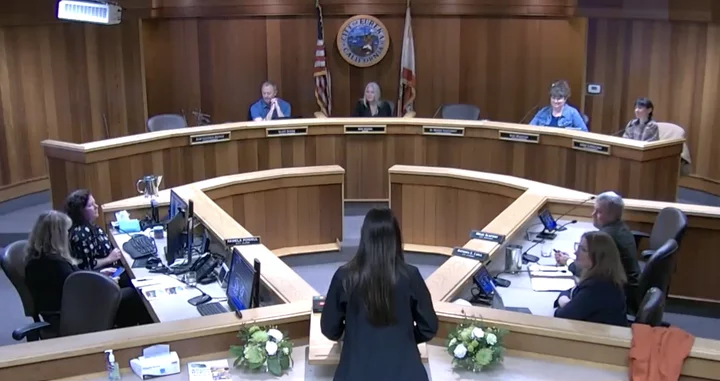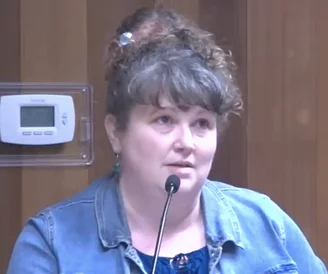Screenshot of Tuesday’s Eureka Council meeting.
###
Someday, the Eureka City Council is going to have to decide how to rezone the former Jacobs Middle School campus to guide future development on the long-blighted site. But not yet.
During Tuesday night’s meeting, the city council considered two options that would change the zoning designation of the Jacobs Campus, which the Eureka City Unified School District agreed to trade to a private developer, “AMG Communities-Jacobs, LLC,” for another piece of land in December. The city council expressed interest in moving forward with an overlay zone that, if approved, would modify future zoning designations on the site, but did not make a formal decision on the item.
The former school site has been a lightning rod of controversy well before Citizens for a Better Eureka launched its “Housing for All and Downtown Vitality Initiative,” an upcoming ballot measure that would block the city’s plans to develop affordable housing on city-owned parking lots and require the city to amend its General Plan to accommodate single- and multi-family housing on the Jacobs Campus. The school district’s controversial decision to sell the property has only exacerbated local concerns about the future of the site, located in Eureka’s Highland Park neighborhood.
In a brief presentation to the council, Assistant Planner Penelope Ponce provided a brief overview of the property and went over some of the key findings from the recent town hall meeting on the Jacobs Campus, which was largely attended by residents of the Highland Park neighborhood.
“Most of the neighbors are concerned about what will happen to the site and how it’s going to affect them,” Ponce said. “There’s also a strong consensus for transparency and public involvement in the planning and development process of the site. In contrast, we found that there is no consensus on the best way to use the site moving forward. Some community members expressed their disappointment that the district’s negotiations with CHP were unsuccessful. Given that the district is selling to a private developer, there was a lot of discussion about what types of private development may be appropriate for the site.”
Many meeting attendees spoke in favor of developing housing on the site. “Top concerns about housing include density, building height, traffic and parking impacts, as well as the resulting effects on the neighborhood’s character safety and property values,” Ponce added. “People also expressed a desire for low-density housing and owner-occupied housing.”
Ponce noted that the sale of the property has yet to be finalized, adding that the developer “has not informed the city about their plans for development.”
While the city doesn’t have absolute control over what kind of development can occur on private property, it does have the power to affect zoning decisions. The Jacobs Campus is currently zoned as “Public Facilities,” a designation that restricts land use to government facilities and schools. Any proposed residential or commercial development at the site would require a zoning change.
Development Services Director Cristin Keyon went over the two options before the council:
- Rezone the site. This option could be completed in a few months and would cost the city an estimated $75,000 for environmental review and an economic feasibility analysis. However, if the Housing for All Initiative is passed by voters during the November General Election the city would be required to rezone the site a second time to be consistent with the initiative, which would cost the city more money.
- Develop a new “Mixed Neighborhood” overlay zone that could potentially be applied to the Jacobs site and other sites within the City in the future. Overlay zones can be applied to specific areas on the city’s Zoning Map “to add special requirements, limitations, or enhanced flexibility on top of the base zoning district standards,” Kenyon said. This option would ensure – regardless of what zone base is adopted for the Jacobs site – that new uses fit the existing neighborhood’s scale and character. The cost is estimated at $40,000.
The council also considered a third option to take no action and see what happens with the property exchange and ballot initiative.
Some residents who spoke during the public comment portion of the meeting seemed confused about the pending land exchange and the city’s involvement in the zoning process.
One commenter, who only identified herself as Patty, complimented staff’s presentation but asked why staff didn’t devote the same amount of time to its “half-assed” Bike Plan update. “It looks really odd to me,” she said, adding that the Bike Plan affects city streets whereas the matter at hand concerned private property.
Another resident, Shannon Townsend, said she was glad to see renewed interest in developing the site but didn’t like how the school district’s negotiations for the property went down. “All this happened behind closed doors – as far as the sale of the property and who the school district sold the property to – and all that seems just kind of icky to me,” she said. “I don’t think we should do anything as a city until we figure out what their intentions are.”
Following public comment, Councilmember Kati Moulton emphasized the importance of keeping the public informed about issues happening in their neighborhoods.
“[P]eople are fired up about this right now,” she said. “I think that the people of the Second Ward deserve to have their voices heard. I think that we need to catch this now and not let it dissolve and become a footnote and let the Jacobs Campus be a pawn in the broader scheme of everything that is happening in Eureka. … The cost of not doing anything is not nothing. The cost of not doing anything is the input, the goodwill and the happiness of people in the Second Ward.”
Moulton added that she is not in favor of “pushing spending that could potentially just end up going out the window,” and spoke in favor of creating an overlay zone for the Jacobs Campus.
Councilmember Leslie Castellano also expressed interest in the overlay option and asked if the public would have an opportunity to provide input on what should be included in the overlay zone. Kenyon confirmed.
Councilmember G. Mario Fernandez asked if city staff have contacted AMG Communities to discuss their plans for the site. City Manager Miles Slattery said, “Yes, multiple times,” adding that staff’s efforts have been unsuccessful. Fernandez said he felt inclined to wait and see what happens with the ballot measure, noting that he “is in favor of an overlay.”
Councilmember Scott Bauer asked how many large-scale development projects the city is currently working on. Kenyon said staff are “actively helping with” five projects located on city-owned property, facilitating community meetings on affordable housing and helping with private developments, including the two ACGC projects being constructed in Old Town.
“Are staff pretty consumed by these projects?” Bauer asked.
“Yes, we’re swamped,” Kenyon said. “We have a lot of balls in the air – adding another ball just means, you know, some other stuff is taking longer … .”
Bauer later added that he generally agreed with his fellow councilmembers, but agreed with Fernandez that the council should wait and see.
After a bit of additional discussion, the council unanimously agreed, with Councilmember Renee Contreras-DeLoach absent, to accept staff’s report and continue the item at a future date.
###
PREVIOUSLY:
- Eureka City Schools Board of Trustees Unanimously Votes for So-Called ‘Land Exchange’ with Mystery Developer
- The Eureka City Schools Board Voted on a Resolution Last Week That Was Not Published Before the Meeting. Is That Legal?
- At Town Hall Meeting, Frustrated Residents Discuss Future Development of Eureka’s Jacobs Campus; Mystery Developer Still Mysterious
###


CLICK TO MANAGE